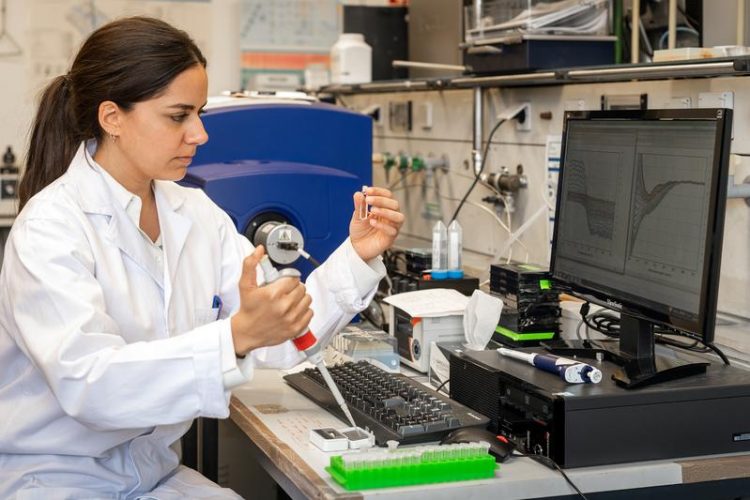Fatal overproduction of antibodies: Mutations in plasma cells play a key role in light chain amyloidosis

PhD student Pamina Kazman examines the folding and stability of antibody domains with the circular dichroism spectrometer of the Chair of Biotechnology. Andreas Heddergott / TUM
Antibodies are vital for the survival of human beings. They typically consist of two longer and thus heavier amino acid chains and two lighter ones. In rare cases, the plasma cells multiply excessively, flooding the body with light antibody chains.
In people suffering from light chain amyloidosis (AL amyloidosis), these light chains are deposited as extremely fine fibers, so-called amyloid fibrils, in tissue or in organs. The disease is often recognized only after the deposits already compromise the function of organs. In many cases AL amyloidosis is fatal.
“To date, little was known about the exact cause of this amyloidosis,” says Johannes Buchner, professor of biotechnology at the Technical University of Munich. “Depending on the organ affected, the symptoms vary considerably. Furthermore, each patient produces different types of antibodies. The disease is thus difficult to diagnose at an early stage.”
A mutation triggers the deadly disease
Using various analytical and database-supported methods, the team of scientists succeeded in identifying eleven mutations caused by the disease in the antibodies of a patient with advanced AL amyloidosis.
Further investigations showed that exactly one mutation was responsible for the destabilization and formation of the disease-causing amyloid fibrils. This mutation causes the unstable light chain to lose its structure after breaking into fragments, which then form the deadly amyloid fibrils.
“Our study shows that mutations that lead to unstable light chains are an important factor in the occurrence of amyloidosis,” says Pamina Kazman, who carried out the majority of the measurements. “In the long term, we hope that these and other studies will lead to new, earlier diagnostic methods and possibly even new treatment options.”
The research was funded by the German Research Foundation (DFG). The protein structures were determined at the synchrotron radiation sources of the Paul Scherrer Institute in Villigen (Switzerland) and the European synchrotron radiation source in Grenoble (France).
Prof. Dr. Johannes Buchner
Professorship of Biotechnology
Technical University of Munich
Lichtenbergstr. 4, 85748 Garching, Germany
Tel.: +49 89 289 13340 – E-Mail: johannes.buchner@tum.de
Fatal amyloid formation in a patient’s antibody light chain is caused by a single point mutation
Pamina Kazman, Marie-Theres Vielberg, María Daniela Pulido Cendales, Lioba Hunziger, Benedikt Weber, Ute Hegenbart, Martin Zacharias, Rolf Köhler, Stefan Schönland, Michael Groll, Johannes Buchner
eLife, online: 10.03.2020 – DOI: 10.7554/eLife.52300
https://www.department.ch.tum.de/en/biotech/ Website of the research group
https://www.tum.de/nc/en/about-tum/news/press-releases/details/35938/ Press release on the website of the Technical University of Munich
https://doi.org/10.7554/eLife.52300 Original publication
Media Contact
All latest news from the category: Life Sciences and Chemistry
Articles and reports from the Life Sciences and chemistry area deal with applied and basic research into modern biology, chemistry and human medicine.
Valuable information can be found on a range of life sciences fields including bacteriology, biochemistry, bionics, bioinformatics, biophysics, biotechnology, genetics, geobotany, human biology, marine biology, microbiology, molecular biology, cellular biology, zoology, bioinorganic chemistry, microchemistry and environmental chemistry.
Newest articles

Sea slugs inspire highly stretchable biomedical sensor
USC Viterbi School of Engineering researcher Hangbo Zhao presents findings on highly stretchable and customizable microneedles for application in fields including neuroscience, tissue engineering, and wearable bioelectronics. The revolution in…

Twisting and binding matter waves with photons in a cavity
Precisely measuring the energy states of individual atoms has been a historical challenge for physicists due to atomic recoil. When an atom interacts with a photon, the atom “recoils” in…

Nanotubes, nanoparticles, and antibodies detect tiny amounts of fentanyl
New sensor is six orders of magnitude more sensitive than the next best thing. A research team at Pitt led by Alexander Star, a chemistry professor in the Kenneth P. Dietrich…





















